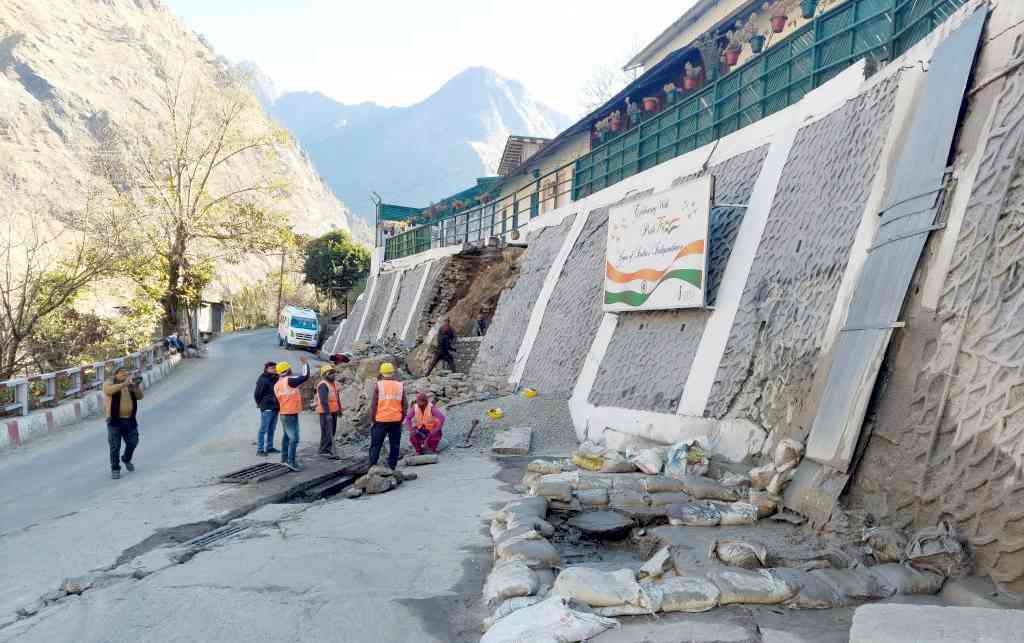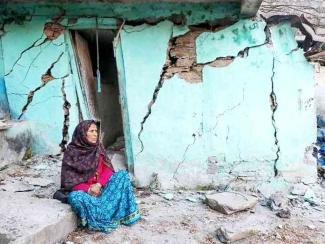The grave situation in which Joshimath finds itself after the recent 107 days of struggle is the fallout of the rapacious policies being implemented in the Himalayan states. The focus of these policies is to exploit the natural resources of the hill states in an unscientific manner to satisfy their greed. In the name of protecting the environment, Uttarakhand is witnessing a veritable deluge of new sanctuaries being opened, 'all weather roads' being constructed, rail lines being planned and hydro electricity generation projects going on in full swing. These human interventions are stripping the mountains of their existential conditions and stability and rendering its inhabitants homeless and jobless. Joshimath is a classic example of this tragedy where many such projects are currently being executed. In spite of the huge environmental cost and associated human tragedy, the government is paying scant attention to ascertain the local geographical and geological conditions as well as human safety before executing the projects.
After the 2013 Kedarnath tragedy, the home-ground of the Chipko movement- Reni village saw 203 workers lose their lives in the Rishi Ganga Project, which itself was washed out, incurring huge financial losses as well. Post Kedarnath tragedy, a committee under the leadership of Ravi Chopra gave many recommendations to avert such man-made calamities in future. Its recommendations of setting up of an early warning system in any project above a height of 2000 m above sea-level were not complied in the 'Rishi Ganga Project', resulting in great human misery. The 520 MW 'Tapovan Vishnugarh' project and the ongoing explosive blasts to construct a road below Joshimath have endangered the very existence of this town. The leader of the ongoing movement to save Joshimath under the banner of ' Joshimath Bachao Sangharsh Samiti' and CPI(ML) leader Atul Sati says that when the 'Tapovan Vishnugarh' project was initiated in 2005, the local residents had raised questions about the feasibility of the project in terms of water discharge in the river and the ill-effects on their employment. The concerned officials had failed to satisfactorily answer these apprehensions. As a result, some concerned citizens raised their voices and as a result the inauguration of this NTPC project had to be done by the then Chief Minister Narain Dutt Tiwari, not from the project site but from Dehradun in February 2007.
However, the movement led by the Samiti continued against all odds. The company used a tunnel boring machine to drill a tunnel which led to an accident in 2009, in which the mountain collapsed over the machine and an aquifer released 700 litres per second of water. To a sensitive person, this accident would have acted as a warning signal for the things to come. But the company continued to work in the old way. In 2010, the movement gained traction again and an understanding was reached in the presence of the Union Energy Minister that the NTPC was compelled to acknowledge that the water crises in Joshimath was the fallout of the ongoing project. A new 16 crore rupee scheme was initiated to supply unrestricted water supply to the town. However, the Government and NTPC backtracked on their promise and when the DPR was made, Joshimath was not listed in the affected zone! Under pressure from the movement, a committee to revisit this project was constituted with the local MLA, environmentalist Chandi Prasad Bhatt, Sangharsh Samiti and a Geologist as its members. Not a single meeting of this committee was held. The company in the meantime continued with its construction activities. But nature could not be cheated and it manifested its response in 2021 in the form of cracks developing in houses and soil. On 17 November, 2021, the Samiti held a mass protest, demanding that the affected zone be surveyed by geologists-environmentalists and other experts. The state government did not heed to this demand.
Unfazed by the callous attitude of the government, Atul Sati contacted many scientists to conduct a survey on behalf of the Samiti. Geologist Navin Juyal, Dr. S.P.Sati and Dr.Shubhra Sharma submitted their report to the Samiti. The report pointed out that one of the major reason for the development of cracks in the houses could be the construction of the tunnel. Though this report was published in many national and local dailies, it hardly affected the government. It took the government another nine months of pleading to finally send a team on 17 August, 2022 for survey. This team was comprised of the Director of Disaster Management Dr. Piyush Rautela as well as scientists from IIT Roorkee, Wadia Institute and Geological Survey of India. The survey was completed in a single day and the request of the Samiti to survey the entire area was rejected. The findings of the report absolved the NTPC or the government of any wrong-doing. Rather, it blamed the rampant construction by residents and unplanned drainage for the state of affairs. Even if the findings are closely scrutinized, it would reveal that the largest man-made construction there include the 4km long ropeway in Joshimath, Garwal Mandal Vikas Nigam's government buildings to name a few. Even the private construction was made with the government's permission. So is the case with the drainage of the town which is taken care of by the government. But the government refused to take any blame for its acts of omission and commission. Incidentally, a report appeared in 1976 presented by the then Commissioner of Garwal, Mahesh Chandra Mishra who has opined that the reason for the recurrent landslides in Joshimath was the fact that the hill of Joshimath was situated on the rubble emanating from the frequent landslides in the region. Therefore, it should not be subjected to blasting or unchecked transportation by vehicular traffic. The report had suggested that tree-felling for projects should be stopped there and farming on slopes should be prohibited. It also recommended construction of paved water exit channels, scientific drainage system and solid embankment of the river. Clearly, these recommendation were disregarded and the area was destroyed by making hydro power projects and broad roads.
On 12 January, 2023, in the Singhdhar region of Joshimath, an aquifer burst open, spilling water in the open. Earlier, on the intervening night of 2-3 January, the residents felt the earth getting warm suddenly to be followed in the morning by water flowing from near a wall in Jaiprakash Industries residential colony. Subsequently, the crack opening widened further. Atul Sati blames it on the action of NTPC which was blasting the tunnel to retrieve its stuck tunnel boring machine. The Samiti again started its protest in view of the increased landslides. The government initially responded by initiating some token relief measures and announcements of rehabilitation package for the affected people. The hydro-electric project and road construction was temporarily stopped. However, there is little on the ground to rehabilitate the affected. It has been more than 100 days since the protest began.
The struggle to save Joshimath has caught the imagination of people all over the country, especially the youth of hill states who have formed a forum named 'Youth for Himalayas' A delegation of this forum reached Joshimath on the 100th day of the movement and expressed their solidarity with the protestors in their bid to save the entire Himalayan range. On the completion of 100 days of struggle, solidarity programs were organized in Ghaziabad, Arunachal Pradesh, Kinnaur, Jammu, Hyderabad, Jodhpur, Vishakapatnam etc. The main demands of the people of Joshimath are -
- Declare the entire Joshimath region as disaster affected zone.
- Make public the report prepared by the eight organizations.
- Terminate the NTPC project with immediate effect and impose a fine on it.
- Permanently stop construction of Helang-Marwari bypass road.
- Announce a comprehensive relief package for the rehabilitation of the affected people of Joshimath.
- Provide sufficient compensation for the damaged property.
- Bring out the truth behind the land subsidence and the way to cope with it.
On 20 April, 2023, after receiving a written assurance from the government, the Joshimath Bachao Samiti suspended its 107 day protest. Atul Sati has said that the government has assured of a positive action of the eleven point demand charter sent by the Samiti to the Chief Minister. Thereafter, the Samiti has postponed its movement for the next 20 days and it will meet on 11 May to decide the next course of action. A large protest programme will also be organized in Joshimath on that day. The Samiti has warned that if by then, the demands do not find a favourable response, a mass campaign will be launched against the government. It has also expressed its gratitude to the various forums that have supported the movement and pledged to work with them for building a broad movement.

Destructive Model of Development is the Issue










